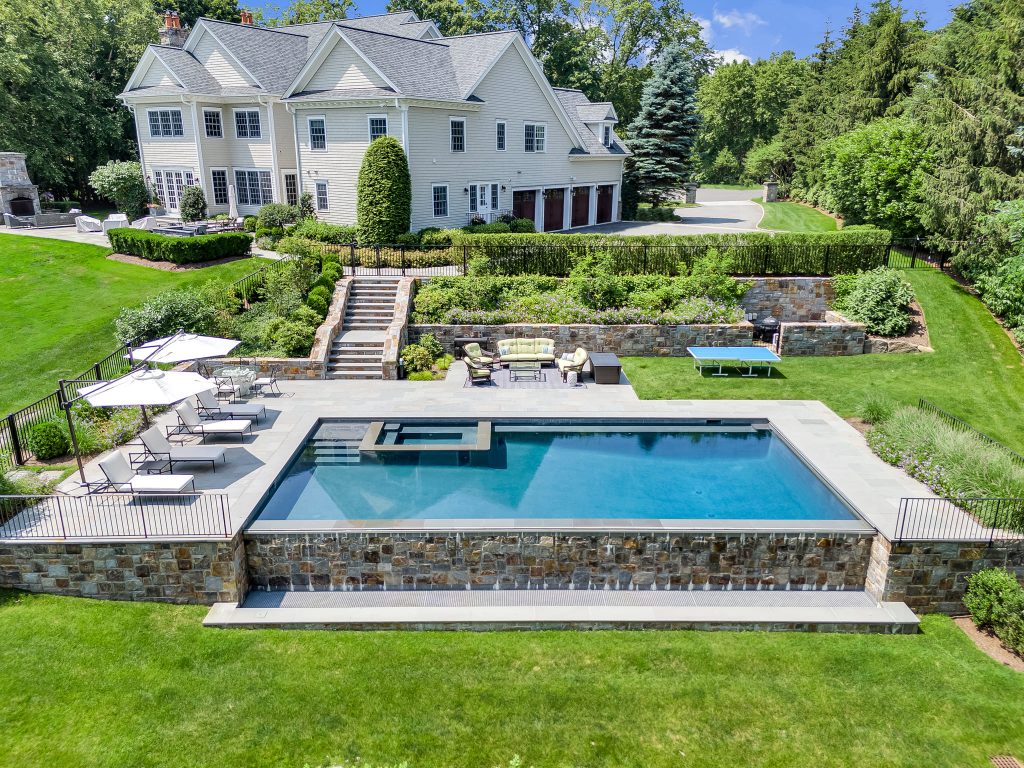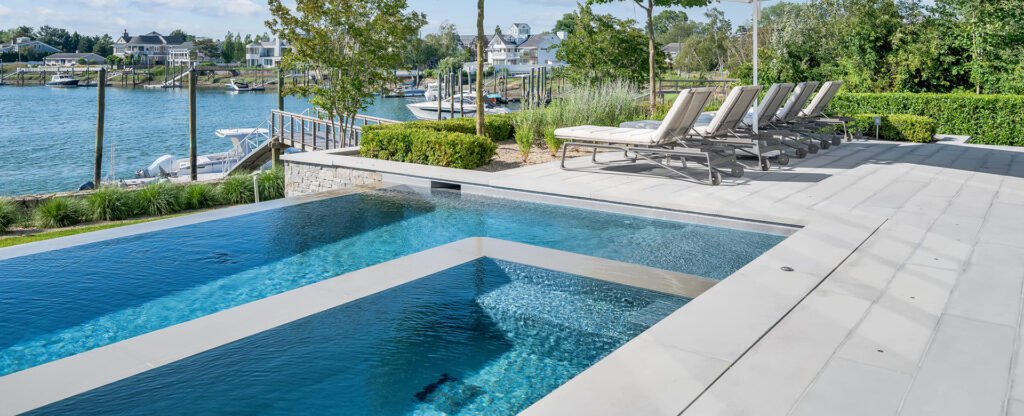Your luxury pool construction along Connecticut’s shoreline will fall short if you’re not melding design and resilience together. The environment is what defines your coastal pool options in CT and pool design in Fairfield projects. The salt air, humidity, and wind from the Long Island Sound enrich your approach with genius and durability.
A pool “made for the coast” isn’t just another backyard upgrade. It’s a design statement built to thrive in salt-rich air and changing weather without losing elegance or comfort. That’s what makes Connecticut shoreline pools a technical and artistic accomplishment.
Quick Answer
A pool “made for the coast” in Connecticut can handle salt air, wind, and bright sunlight with grace, elegance and comfort. It uses corrosion-resistant materials, shaded areas, wind baffles, warm-toned lighting, and native landscaping. Every detail is selected for longevity, style, and effortless enjoyment throughout the coastal seasons.
How Coastal Conditions Shape Pool Design in Fairfield and Beyond
Coastal exposure molds every design decision. The same breezes that cool the Sound can scatter leaves, and intense sunlight fades finishes quickly. Homeowners planning pool design in Fairfield near the coast must consider how these forces interact.
Experienced designers orient pools for late-day warmth while reducing glare. Wind baffles, hedges, or glass screens keep air movement comfortable. Drainage design matters too; directing runoff away from salt-sensitive materials.
Smart coastal pool strategies:
- Sun: Position the pool for light during the warmest hours but add adjustable shade.
- Wind: Use landscaping or glass partitions to block gusts without losing the view.
- Water: Grade and drain properly to keep saltwater or sand from damaging finishes.
In Fairfield and nearby Westport, these design details create comfortable luxury coastal pool designs that withstand the weather. Many Fairfield coastal pool builders also incorporate natural stonework and glass fencing to balance protection with uninterrupted views.
The Best Materials for Building a Long-Lasting Coastal Pool in CT
Material selection makes or breaks the lifespan of any coastal pool in CT. Salt and humidity take a huge, relentless toll on metal fixtures and exposed surfaces. Using marine-grade or UV-stable materials prevents premature wear and reduces maintenance costs.
| Material/Feature | Why It Matters for a Coastal Pool |
| Marine-grade stainless steel | Resists corrosion and pitting from salt exposure |
| Epoxy-coated hardware | Protects rails, anchors, and bolts against rust |
| Glass tile or quartz aggregate | Nonporous and easier to clean of salt residue |
| Composite decking | Won’t warp or bleach in coastal humidity |
| UV-stable finishes | Preserve color under strong sunlight |
Pool design in Fairfield projects that include these finishes consistently outperform inland builds. They keep brightness, texture, and structural integrity despite years of salt exposure.
Creating Year-Round Comfort Around Your Connecticut Coastal Pool
A well-planned coastal pool invites year-round relaxation while spitting the face of corrosion. The key lies in controlling the microclimate around the pool. Many pool design in Fairfield professionals create shaded and sheltered zones that protect from cool breezes and midday heat.
Top comfort-enhancing features:
- Pergolas or cabanas: Provide soft shade while framing shoreline views.
- Retractable awnings or louvers: Allow custom control of light and airflow.
- Windbreak planting: Layer native shrubs and ornamental grasses for natural protection.
- Sheltered seating zones: Arrange furniture near walls or dense greenery.
- Marine-rated fabrics: Resist mildew and fading under humid coastal air.
With careful comfort planning, a coastal pool feels inviting from spring through fall, even on breezy days.
How to Light Your Coastal Pool Without Glare or Harsh Reflections
Lighting transforms the way a coastal pool in CT looks and feels after sunset. But at the coast, glare control is just as important. Harsh lighting can scream off water, glass, or neighboring windows.
Best Practices for Coastal Pool Lighting:
- Use warm tones (2,700–3,000K): These mimic natural dusk light.
- Layer illumination: Blend ambient, task, and accent lighting for depth.
- Direct fixtures downward: Reduce surface reflection across the pool.
- Choose corrosion-resistant housings: Ensure fixtures last through salty humidity.
Lighting is often where pool design in Fairfield trends weave into coastal practicality. Designers favor subtle, amber-toned light that highlights texture and landscaping instead of overpowering it.
For deeper insight, see our post on night lighting for Connecticut coastal pools, which explores fixture placement and optical control in shoreline settings.
The Smartest Coastal Landscaping Choices for Fairfield-Area Pools
Coastal landscaping is decorative and defensive. Plant choices help buffer wind, absorb salt spray, and anchor soil near the waterline. That invites native and salt-tolerant species to thrive, so there’s little maintenance on your end.
Recommended coastal-ready plants:
- Beach grass (Ammophila breviligulata): Durable, wind-tolerant groundcover.
- Inkberry holly (Ilex glabra): Evergreen privacy hedge.
- Rosa rugosa: Colorful, fragrant, and salt-resistant.
- Switchgrass or fountain grass: Add movement and visual softness.
These species integrate into natural landscapes for pool design in Fairfield, where function meets natural elegance. Proper spacing and mulching help stabilize sandy soil and sightlines toward the Sound.
Simple Maintenance Habits That Keep Coastal Pools Beautiful for Years
Even the most durable materials will fail you in coastal climates without upkeep. Preventive care keeps salt, humidity, and temperature changes from wearing down finishes. A coastal pool in CT plan should include annual and seasonal maintenance steps from the start.
Coastal Pool Maintenance Checklist:
- Rinse exposed decking and metal after major storms.
- Schedule biannual inspections for fixtures, lighting, and joints.
- Apply surface sealant every five to seven years.
- Replace hardware only with epoxy-coated or marine-grade parts.
- Maintain plant buffers to filter airborne salt and debris.
These steps help residential coastal pools remain pristine while reducing long-term maintenance costs. Many shoreline homeowners also schedule CT shoreline pool installation consultations in the fall to prepare for spring upgrades or remodels. See our post about when you should start to swim before Memorial Day for more insights here,
Design Details That Make Your Connecticut Coastal Pool Stand Out
A coastal pool should complement the architecture of its surroundings. Fairfield-area designs often draw from the natural textures and colors of the shoreline. Incorporating these subtle cues helps the pool feel like an extension of the property instead of a tacked-on afterthought.
Design touches that elevate coastal builds:
- Teak or driftwood-tone furniture for a relaxed, natural feel.
- Rounded coping edges to echo stone ledges.
- Pale stone decking that stays cool in full sun.
- Frameless glass fencing for protection without blocking views.
Each detail skyrockets beauty and performance. Glass fencing, for example, doubles as a windbreak while maintaining a seamless connection to the coastal scenery.
Coastal vs. Inland Pools: What Homeowners Need to Know Before Building
| Design Factor | Coastal Pool (CT) | Inland Pool |
| Material Selection | Marine-grade steel, UV-stable finishes | Standard materials |
| Lighting Design | Warm, glare-controlled fixtures | Brighter, mixed color tones |
| Landscaping | Salt-tolerant native plants | Ornamental shrubs, minimal screening |
| Maintenance Needs | Higher due to salt and humidity | Lower, mainly seasonal |
| Orientation | Optimized for wind and sunlight | Focused on shade or privacy |
This comparison illustrates why pool design in Fairfield and other shoreline communities need such specialized knowledge. Designs built for inland conditions simply can’t endure the coastal environment.
Key Takeaways: Building a Pool That Truly Belongs on the Connecticut Coast
- Design for exposure. A coastal pool in CT should expect wind, sun, and salt.
- Use marine-grade materials. They resist corrosion and UV damage.
- Blend durability and design. Every feature should serve both comfort and function.
- Adopt glare-free lighting. Warm tones create coastal ambiance.
- Landscape with purpose. Native plants act as natural windbreaks and erosion control.
- Plan maintenance early. Long-term care is part of every successful design.
Bringing It All Together: Designing a Pool That Feels at Home by the Sound
A pool “made for the coast” captures the rhythm of its surroundings. For pool design in Fairfield homeowners, that means combining resilience, luxury, and effortless usability. The result is an outdoor space that thrives under salt air, shifting light, and seasonal breezes.
Explore How Do Fairfield Homes Get a Pool on Ledge—Stress-Free? for insight into how local builders manage complex terrain and access challenges along the coast.
Homeowners planning a coastal pool in CT can consult local experts who understand both the design and environmental factors unique to Connecticut’s shoreline. A truly refined coastal pool design goes with the flow instead of fighting nature. Every reflection, breeze, and ripple becomes part of a setting that’s timeless, sustainable, and unmistakably Connecticut.



